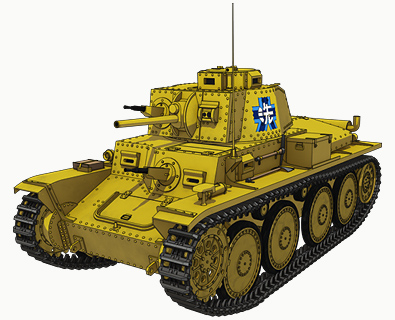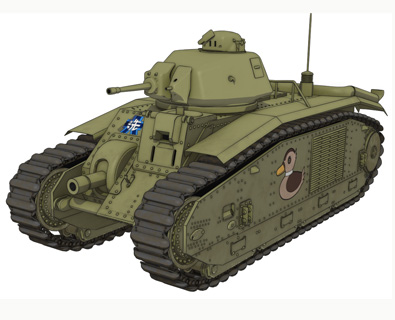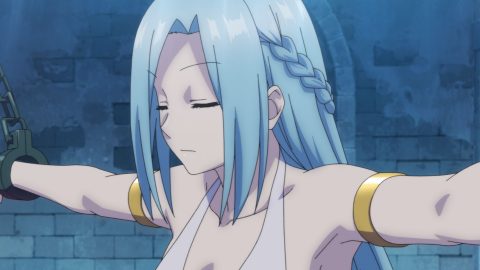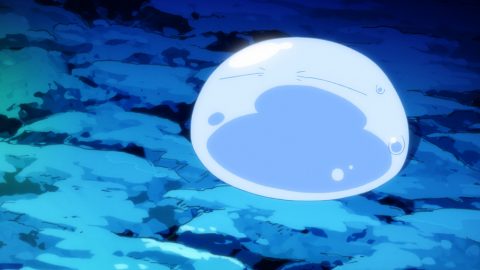"Girls und Panzer" is a hugely popular anime about high school girls who ride tanks and practice a martial art known as "Sensha-do." The tanks that appear in the anime are real, and their historical facts and performance have been faithfully recreated. One of the charms of this anime is seeing the tanks, faithfully recreated using CG, moving all over the screen. In this article, we'll introduce the tanks of the Oarai Sensha-do team, to which the main character belongs.
Panzer IV D
Among the German tanks of World War II, the Panzer D was a workhorse of the German military, produced and used for a long time until the end of the war, with various modifications. The Panzer D was the first mass-produced model of the Panzer IV series. The 75mm gun was a large caliber for the first half of the war, but its short barrel meant it lacked the power to penetrate armor, and it struggled against heavily armored tanks like the British Matilda and French B1bis. Furthermore, with the start of the German-Soviet War, the appearance of the Soviet T-34 made it even less powerful. As mentioned above, it continued to be improved upon with longer barrels and additional armor. 229 D-type tanks alone were produced, with a total of 8,344 produced in the entire series (excluding A-type through J-type, prototypes, and derivatives). It also commands the Oarai Tank Road Team as the Anglerfish Team's commander vehicle.
Panzer IV Ausf. D Modified F2 Specification
This is an improved version of the Panzer IV Ausf. D, which appears in episode 8. Historically, the Panzer IV Ausf. F was unable to destroy the T-34 due to its short barrel. The F2 model was born by replacing the short barrel of the F model with a long barrel (43 caliber 75mm gun). This made it possible to defeat British tanks that had previously been ineffective, and it became a feared force. Only 174 vehicles were produced.
Panzer IV D-type Modified/H-type Specification
This is the final form of the Anglerfish Team, appearing in Episode 10. The historical H-type is equipped with an even longer .48 caliber 75mm cannon than the F2-type. Additionally, additional armor called "Schurzen" is attached around the hull. This armor protects against anti-tank rifles and bullets. It is also the most produced vehicle of the Panzer IV series, with 3,774 units produced.
38t Tank Type B/C
This light tank was officially adopted by Czechoslovakia in 1938. After Czechoslovakia was annexed by Germany in 1939, it served as Germany's main battle tank. It had better performance than the Panzer I and Panzer II tanks used by Germany at the time, and was active in the early stages of the war. However, while most German tanks that came afterwards were five-seater, this tank had four crew members, with the commander also acting as the gunner. This made it difficult to concentrate on command. It also had drawbacks, such as manual turret rotation. Also, its 37mm gun was no match for the heavily armored tanks that began to appear after the war began, and it gradually disappeared. The Ausf. A was the Czechoslovakian specification, the Ausf. B was the German specification, and the Ausf. C was a type with even stronger armor and finer details. The Ausf. B/C that appears in the story is a mixture of Ausf. B and Ausf. C specifications. The "t" in 38t is not a unit of weight, but the Czechoslovakian "t".
Hetzer (38t tank modified Hetzer specification in the movie)
This light tank destroyer was built by BMM, a Czechoslovakian company that built the 38t tank, during the final stages of the war. It was built using the technology and components of the 38t, but the chassis and road wheels are of new standards, making it an entirely different tank. Although it is equipped with a long-barreled 75mm gun in a small body, which hinders mobility and visibility, it is a vehicle with high firepower and high productivity. The Hetzer itself does not appear in this work, but rather a 38t light tank modified using a modification kit known as the "Hetzer Modification Kit." It appears from the 10th chapter. Although it has mobility not found in real life, this "38t Tank Modified Hetzer Specification" is depicted as the actual historical Hetzer.
Type 89 Medium Tank Model A
This was Japan's first domestically produced tank, developed by the Imperial Japanese Army. Development began in 1928, but at the time, it was not intended for tank-on-tank combat and was intended as a vehicle to support infantry. Since it only needed armor to defend against machine guns and match the walking speed of infantry, its mobility and anti-tank attack power were low compared to later tanks. However, it was deployed in the Manchurian Incident in the early 1930s and achieved great success. It was deployed in tank-versus-tank battles along with the Type 95 light tank and Type 97 medium tank during the Nomonhan Incident in 1939. This battle made Japan keenly aware of the lack of performance in its tanks, but it did not have the resources to improve them, and due to a shortage of tanks, the Type 89 medium tank was also deployed in subsequent battles. The Type A in this work was powered by a gasoline engine, but the later Type B was powered by a diesel engine.
StuG III Ausf. F
This assault gun was developed by Germany as an infantry support vehicle based on the Panzer III tank. An assault gun is a type of self-propelled artillery vehicle equipped with a fixed turret to support infantry. The StuG III (StuG III) models A to E were equipped with short-barreled 75mm guns, but a gun capable of destroying tanks was required for infantry support, so the F model was equipped with a long-barreled 75mm gun. Additionally, its low height made it difficult to hit and it was well-suited for ambushes. Initially, it was used in anti-infantry battles, but gradually it moved away from infantry support and took part in pure anti-tank battles, where it performed very well. This vehicle, especially the final model, the G model, was mass-produced until the end of the war.
M3 Medium Tank Lee
This tank was hastily developed by the United States, which was lagging behind Germany in tank development. The M3 required a main gun comparable to the 75mm gun of the German Panzer IV tank. However, the United States lacked the technical experience to mass-produce large rotating turrets, so the 75mm gun was fixed to the right front of the hull and a 37mm gun was mounted in the turret. Furthermore, the use of an aircraft radial engine resulted in a high vehicle height, making it easy to spot from a distance. However, this was because the M3 was developed as a stopgap until the development of its successor, the M4 medium tank, was completed. Rather than developing an engine from scratch, the M3 chose an engine that could be procured quickly and in large quantities. Furthermore, thanks to America's advanced mass production technology, which allowed any factory to produce any part according to the design, replacements could be quickly procured in the event of a battlefield failure. The 75mm gun's performance was also solid, and its reliability led to its adoption by the British Army, where it was highly valued. Incidentally, "Lee" was the nickname given to the American-spec M3 by the British, while the M3 customized for British use was called "Grant." Both names are derived from the names of generals in the Confederate and Union armies during the American Civil War.
B1bis
This heavy tank, also known as the Char B1bis (Char is French for "chariot"), was developed by France. "bis" means "second" in French, but the original B1 was developed in the 1920s as a tank equipped with a large cannon for infantry support. Development of the bis began soon after, with improvements to the engine and turret and strengthened armor. Its distinctive features were a 75mm gun mounted at the front of the hull and a 47mm gun in the turret. Its 60mm thick front and side armor made it tough enough to withstand the 37mm guns that were the mainstay of German tanks at the time. It posed a threat to the German army, but French vehicles at the time lacked radios (though they did have Morse code transceivers), leading to a lack of coordination on the battlefield. German tanks, using close mobile radio communications, were able to pierce a hole in the armor, the radiator grille (ventilation opening) on the left side of the hull, destroying it. Nevertheless, it can be said that this heavily armored tank influenced later German tanks.
Type 3 Medium Tank Chi-Nu
This medium tank was developed by the Imperial Japanese Army in the latter stages of World War II to counter the American M4 medium tank. In an effort to quickly deploy it in combat, it was equipped with a 75mm field gun, the Type 90 field gun, almost as is, mounted on the chassis of a Type 1 medium tank. For this reason, it has a special structure in which it is fired by pulling a rope called a "ryujou" (pulling rope) rather than a trigger. In terms of defensive capabilities, it is on par with the Type 1 medium tank but inferior to the M4, and due to the aforementioned structure, it has a low rate of fire, a drawback due to it being a hastily built tank, but its main gun was powerful enough that it could finally compete with the M4 medium tank. However, because it was deployed domestically in anticipation of a decisive battle on the Japanese mainland, the war ended without it ever being used in actual combat.
Porsche Tiger
Struggling against the Allied forces' new tanks, Germany issued development orders to Henschel and Porsche to create a new, heavily armored tank with high firepower. The Porsche Tiger lost the competition and was never mass-produced. It was a system that anticipated today's hybrid vehicles, running on an electric motor powered by a gasoline engine. The idea was that because the rotation speed could be adjusted simply by adjusting the power, gear changes and steering devices could be eliminated, resulting in more reliable operation and fewer malfunctions. However, in reality, it was too complicated for the technology of the time, and it suffered from numerous problems and was not adopted. However, with the same 88mm turret as the Tiger I and armor that rivaled the Tiger I in defensive capabilities, it was Oarai's strongest tank.
Mark IV Tank
This is an improved version of the British Mark I tank, known as the world's first tank. The engine cooling fan, ventilation fan, and fuel tank are located externally, significantly improving crew comfort. Like previous diamond tanks, there were male models equipped with 57mm and 6-pounder guns, and female models equipped with 7.7mm machine guns. This tank was the first to experience tank-versus-tank combat, fighting against German A7V tanks. The result was a tactical defeat, with two female models lost out of three Mark IVs (one male and two female). (Although the Germans subsequently retreated, resulting in a strategic victory.) In response, male and female models with a 6-pounder machine gun mounted on only one side were produced, marking the beginning of anti-tank awareness. It required a crew member each to brake and change gear, requiring four people just to drive. In addition, four gunners and machine gunners were required, for a total of eight people, which was a drawback of previous diamond tanks. However, various variants were developed, such as those modified for transporting supplies, or with the armament removed and a crane installed. In this work, it appears as the ninth vehicle in the Final Chapter series at Oarai. It is customized with gears and has a crew of five: two drivers, two gunners, and one commander. A male model equipped with a 6-pounder gun will also be released.
















